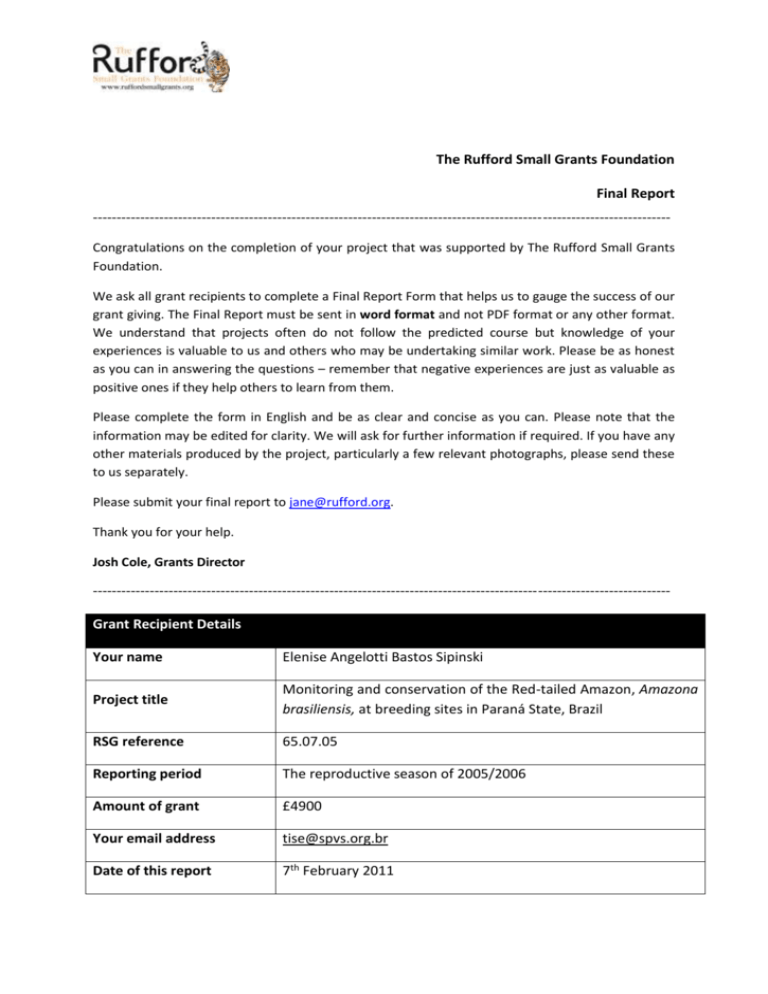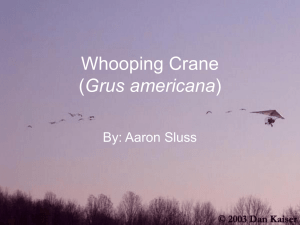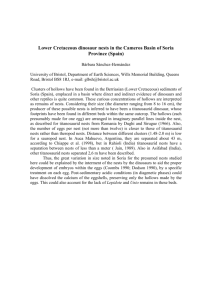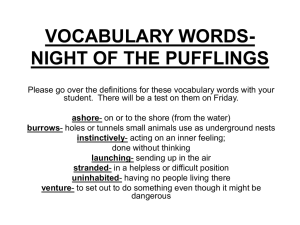Final Report - The Rufford Foundation
advertisement

The Rufford Small Grants Foundation Final Report -------------------------------------------------------------------------------------------------------------------------Congratulations on the completion of your project that was supported by The Rufford Small Grants Foundation. We ask all grant recipients to complete a Final Report Form that helps us to gauge the success of our grant giving. The Final Report must be sent in word format and not PDF format or any other format. We understand that projects often do not follow the predicted course but knowledge of your experiences is valuable to us and others who may be undertaking similar work. Please be as honest as you can in answering the questions – remember that negative experiences are just as valuable as positive ones if they help others to learn from them. Please complete the form in English and be as clear and concise as you can. Please note that the information may be edited for clarity. We will ask for further information if required. If you have any other materials produced by the project, particularly a few relevant photographs, please send these to us separately. Please submit your final report to jane@rufford.org. Thank you for your help. Josh Cole, Grants Director -------------------------------------------------------------------------------------------------------------------------Grant Recipient Details Your name Elenise Angelotti Bastos Sipinski Project title Monitoring and conservation of the Red-tailed Amazon, Amazona brasiliensis, at breeding sites in Paraná State, Brazil RSG reference 65.07.05 Reporting period The reproductive season of 2005/2006 Amount of grant £4900 Your email address tise@spvs.org.br Date of this report 7th February 2011 1. Please indicate the level of achievement of the project’s original objectives and include any relevant comments on factors affecting this. Objective Monitoring and protecting reproductive spots in Rasa, Gamela and Grande Islands. Not Partially achieved achieved Fully achieved Yes Comments As a result of the reproductive season of 2005/2006, 23 active nests were observed. Ilha Rasa reproductive site is the area that obtained a higher occupation rate of artificial nests (47%), was successful in 66% of installed nests, and resulted in 24 births. Ilha das Gamelas obtained an occupation rate of 50%, was successful in 75% of installed nests, and resulted in 9 births. Ilha Grande site obtained a lower occupation rate, 40% of installed nests (artificial nests), was successful in 44% of laid eggs, and resulted in 5 births. 2. Please explain any unforeseen difficulties that arose during the project and how these were tackled (if relevant). Ilha Rasa is the breeding site of preference but unfortunately there is some pressure from the population. The tree preferred by the species is the guanandi that is also used by the population to build canoes and houses. In the past, the timber was only used by the community but its use has intensified due to the trading of canoes and boards to other coastal communities in Paraná. The community does not remove the parrots anymore, it has already learnt that the species is important, but for the population it is difficult to understand that to protect the species they cannot cut trees from the forests. On the other hand, the inspecting offices do not have enough people and infrastructure to control and penalise such activities and the results are not that impressive. It is a projects goal to minimise this impact. An initial action is a study on the density of the guanandi aiming at assessing its stock on the island. With these dates it will be possible to check adequate handling measures for this species, considered as a key factor for the survival of the Amazona brasiliensis. 3. Briefly describe the three most important outcomes of your project. Among researched areas, Ilha Rasa is an important breeding site as 95% of the nests in activity are found on this site. It is also the area where the biggest numbers of holes were found (72%), of which 30% were used as nests. The results show that Ilha Rasa is often chosen by the Amazona brasiliensis for its breeding site in the state of Paraná. During the monitoring it was possible to see that nine different vegetal species were used for nest-building. However, one was preferred, the guanandi (Caloplyllum brasiliense)- used in 37.5% of the cases. During the monitoring it was possible to protect breeding sites; for 7 months, the nests will be observed around the clock by project staff. 4. Briefly describe the involvement of local communities and how they have benefitted from the project (if relevant). Two resident individuals of the communities of Ilha Rasa have performed work for the project since 1998. They are hired by the project and receive all benefits provided in the Brazilian labour law. In the Ilha Rasa community where the workers live and the project team stays, residents are highly sensitised to the cause. They are very interested. They have perceived the population increase of the parrots on the island, specially also do to the parrots’ proximity to the edge of the Forest bordering the community. 5. Are there any plans to continue this work? The red-tailed parrot conservation project on the coast of Paraná (Brazil) started being developed by SPVS in 1998. To do this, management and protection strategies were designed and executed for the nests. Artificial nests of wood and PVC/plastic were built and installed and have been guaranteeing a successful birthrate for chicks and an increase in the parrot population. The data obtained over the years reinforce the importance of planned management actions for the conservation of endangered species. The installation of artificial nests began as a way of replacing the natural nests that were no longer available at the monitored breeding sites. From 1998 to 2006 there was a loss of approximately 60% of the natural nests available. This fact could have compromised the population increase considerably if no management measures had been carried out. Studies on the psittacidae species demonstrate loyalty to the breeding sites, even when there is a decline in the availability of cavities. In addition to helping to increase the population, the monitoring of the nests also protects against the stealing of chicks from artificial and natural nests at the breeding site. The artificial nests are installed in tall trees to make access difficult. The constant presence of two island residents (project employees), researchers and interns protect against the action of people who want to capture the chicks for the illegal commerce of wild animals. It is likely that if the Project didn’t carry out these actions the removal of chicks would occur more frequently. Various community members also have the same perception. In the community where the workers live and the project team stays, residents are highly sensitised to the cause. Unfortunately other communities that do not have direct contact with the project do not share the same perception. Many still use the forest to cut down trees, hunt and capture parrot chicks. Therefore work needs to be developed in these other communities to carry out actions to benefit them. Many of these communities lack basic needs like education, healthcare and alternative sources of income and they still overexploit natural resources as a means of survival. According to the Plan of Action for the conservation of the species (drawn up with the support of the state environmental agency (IAP) and state researchers) the monitoring and protection actions at the breeding site and the population censuses are considered priority strategies that should be continual. At the same time environmental education actions and support for income generating activities in the local communities were also considered fundamental strategies for the conservation of the species in the region. Therefore the red-tailed parrot conservation project team proposed a partnership with the SPVS conservation and development team to formulate a species conservation proposal focusing on actions to support the community of Ilha Rasa. Based on this scenario and the experience of the SPVS team a meliponiculture project (native stingless bees) will be proposed for the communities of Ilha Rasa. 6. How do you plan to share the results of your work with others? The project staff are in frequent contact with community residents and environmental agencies (Ibama) to give them suggestions to help in the monitoring and regulation actions on the coast of Paraná focusing on the red-tailed parrot and its main breeding, feeding and roosting sites. Some of these actions include: Distributing an informational booklet about the species, the forest and results of the project. Providing information to Ibama, the Environmental Police (Força Verde) and the federal police about the red-tailed parrot and the threats it faces, aiming to establish investigative actions for trafficking of wild animals on the coast. Preparing materials with information about the priority locations for conservation efforts and characteristics of the species for Ibama, as requested by the Head of Ibama in Paranaguá. Providing information for the Lieutenant of the environmental police about the species and the threats that it faces, to establish the strategic planning for regulating the coast of Paraná. Preparing an Action Plan in partnership with environmental agencies in the State (IAP) and researchers from the State with recommendations for the conservation of the species and the region. This document is published by the environmental agencies in the State and will serve as a guideline for the conservation of the species. 7. Timescale: Over what period was the RSG used? How does this compare to the anticipated or actual length of the project? This project is part of a larger conservation strategy for the species in the State of Paraná. The data obtained as a result of this project reinforce the importance of planned management actions for the conservation of endangered species. This support of Rufford has made it possible to monitor nest activity and protect the main breeding sites of the parrot on the coast of Paraná for one year (The reproductive season of 2005/2006). 8. Budget: Please provide a breakdown of budgeted versus actual expenditure and the reasons for any differences. All figures should be in £ sterling, indicating the local exchange rate used. Item Budgeted Amount Meals for project 700 staff in the field Transport for project 600 staff in the field Lodging 1.000 Actual Amount 700 Difference 600 0 1.000 0 Boat maintenance 600 600 0 Climbing equipment 500 500 0 Binoculars 300 300 0 Office materials 100 100 0 Artificial nest-box 400 material Build nests service 700 400 0 700 0 Total 4.900 4.900 Comments 0 9. Looking ahead, what do you feel are the important next steps? It is important to point out that Ilha Rasa was considered one of the most important breeding sites in the State of Paraná (Sipinski 2003; Carrilho et al, 2002; Scherer-Neto 1998). Studies on psittacidae species demonstrate loyalty to the breeding site even when there is a decrease in the available cavities. On Ilha Rasa there was a high rate of reuse of natural nests and artificial nests located near the old natural nests that were no longer available. In the future, it is possible to increase the number of available natural nests as a result of the overall conservation of the forest. The project actions for reducing the removal of tree species at the breeding site have been getting positive results. However, the formation of hollows/natural nests takes time in the natural environment. Until this scenario can be reverted, and new natural nests become available in the forest, the strategy of installing and monitoring artificial nests will be a project priority. The community where the workers live and the project team stays is quite supportive of the cause. They are interested and have perceived the increase in the population of the parrots on the island and on the edge of the forest. Unfortunately other communities that are not aware of the project, do not have the same perception, since many of them use the forest to cut down trees, hunt and capture parrot chicks. Therefore, it is necessary to work more closely with the other communities and support the partnership of social institutions working with these communities. Many of them lack education, healthcare and viable activities for generating income, as they depend heavily on the natural resources for survival. 10. Did you use the RSGF logo in any materials produced in relation to this project? Did the RSGF receive any publicity during the course of your work? Use the RSGF logo in site SPVS. Bóçon R. ; Sipinski., E.A. B. 2005. The Management of Artificial Nests in the Conservation of The Red-tailed-parrot (Amazona brasiliensis). Annual meeting of the Society for Conservation Biology – Brasilia Sipinski, E. A .B., Bóçon. 2005. The Conservation of The Red-tailed Parrot (Amazona brasiliensis) in The State of Parana – Brazil.Annual meeting of the Society for Conservation Biology – Brasilia 11. Any other comments? Many of the natural nests available are in a state of decay; consequently, the number of natural nests has been decreasing with each reproductive period. Based on this result, the project plans to increase the number of artificial nests in the reproductive sites. The results demonstrate the importance and efficiency of the artificial nests as a conservation strategy for the red-tailed parrot in the wild.





